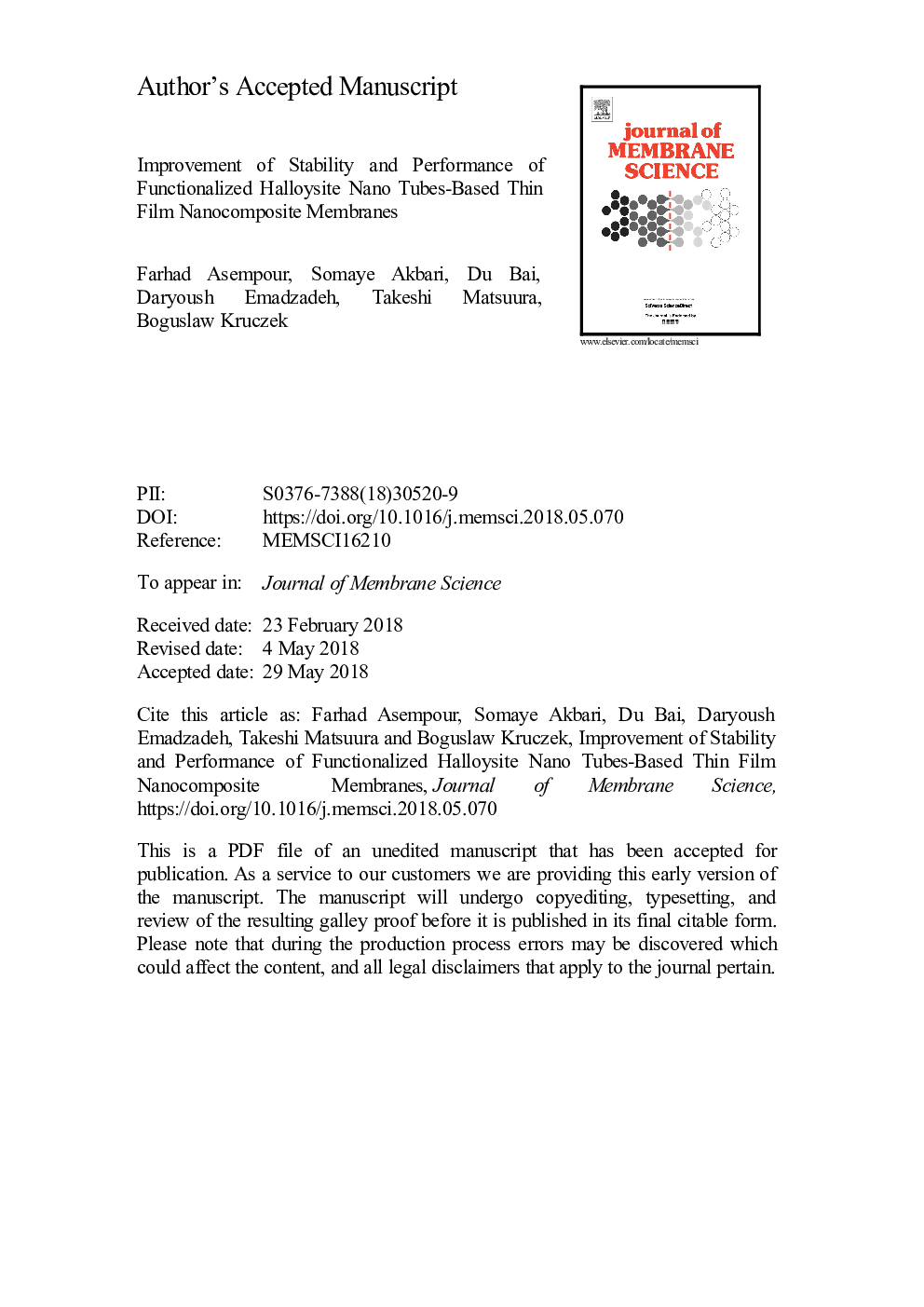| کد مقاله | کد نشریه | سال انتشار | مقاله انگلیسی | نسخه تمام متن |
|---|---|---|---|---|
| 7019712 | 1455936 | 2018 | 31 صفحه PDF | دانلود رایگان |
عنوان انگلیسی مقاله ISI
Improvement of stability and performance of functionalized halloysite nano tubes-based thin film nanocomposite membranes
ترجمه فارسی عنوان
بهبود پایداری و عملکرد غشاهای نانو کامپوزیتی نازک مبتنی بر نانو لوله های کارا شده با هالویزیت
دانلود مقاله + سفارش ترجمه
دانلود مقاله ISI انگلیسی
رایگان برای ایرانیان
کلمات کلیدی
غشاء نانو کامپوزیت نازک فیلم، اسمز معکوس، نانو لوله های هالوئیزیت، شستن نانوذرات، دندریمر،
موضوعات مرتبط
مهندسی و علوم پایه
مهندسی شیمی
تصفیه و جداسازی
چکیده انگلیسی
One of the major reasons for the limited commercial availability of the TFN membranes is the poor compatibility and adhesion between the embedded nanoparticles and polyamide matrix. Herein, we addressed this issue by functionalization of nanoscale additives to enhance their interactions with the polymer matrix and thereby reducing their leachability. Reverse osmosis TFN membranes were fabricated by in-situ interfacial polymerization of MPD and TMC, and incorporation of functionalized Halloysite Nanotubes (HNT). Exterior surfaces of the HNT were modified by adding three different functional groups: amine groups (HNT-NH2), the first generation of poly(amidoamine) (PAMAM) dendrimers (HNT-G1), and carboxylic acid (HNT-COOH). The modified HNT were characterized by ATR-FTIR, TEM, SEM, zeta potential, and thermogravimetric TGA analyses. Surface morphology and physicochemical properties of the HNT-based TFN membranes were investigated by SEM, ATR-FTIR, XPS, and contact angle measurements. Potential reactions of the functionalized HNT with TMC were investigated by ATR-FTIR. Also, the leachability of HNT from the membranes was studied by using a leaching test in a batch incubator followed by their tracing with ICP-MS. Furthermore, membrane selectivity and permeate flux were evaluated in cross-flow reverse osmosis (RO) desalination experiments using a synthetic brackish water. The water flux of all HNT-based TFN membranes compared to the reference TFC membrane increased without sacrifice of salt rejection. The maximum increase of nearly 100% was observed for HNT-COOH-based TFN membrane with salt rejection of 99.1%â¯Â±â¯0.1%. The TFN membranes with HNT-NH2 and HNT-G1 exhibited significantly lower leaching of nanoparticles in comparison to other TFN membranes. Decreased leachability of these membranes is attributed to the formation of covalent bonds between the amine groups of HNT-NH2 and HNT-G1, and the acyl chloride of TMC monomers.
ناشر
Database: Elsevier - ScienceDirect (ساینس دایرکت)
Journal: Journal of Membrane Science - Volume 563, 1 October 2018, Pages 470-480
Journal: Journal of Membrane Science - Volume 563, 1 October 2018, Pages 470-480
نویسندگان
Farhad Asempour, Somaye Akbari, Du Bai, Daryoush Emadzadeh, Takeshi Matsuura, Boguslaw Kruczek,
